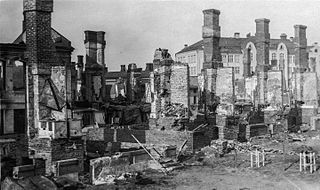
The Finnish Civil War was a civil war in Finland in 1918 fought for the leadership and control of the country between White Finland and the Finnish Socialist Workers' Republic during the country's transition from a grand duchy of the Russian Empire to an independent state. The clashes took place in the context of the national, political, and social turmoil caused by World War I in Europe. The war was fought between the Red Guards, led by a section of the Social Democratic Party, and the White Guards, conducted by the senate and those who opposed socialism with assistance late in the war by the German Imperial Army at the request of the Finnish civil government. The paramilitary Red Guards, which were composed of industrial and agrarian workers, controlled the cities and industrial centers of southern Finland. The paramilitary White Guards, which consisted of land owners and those in the middle and upper classes, controlled rural central and northern Finland, and were led by General C. G. E. Mannerheim.

The Russian Revolution of 1905, also known as the First Russian Revolution, began on 22 January 1905. A wave of mass political and social unrest then began to spread across the vast areas of the Russian Empire. The unrest was directed primarily against the Tsar, the nobility, and the ruling class. It included worker strikes, peasant unrest, and military mutinies. In response to the public pressure, Tsar Nicholas II was forced to go back on his earlier authoritarian stance and enact some reform. This took the form of establishing the State Duma, the multi-party system, and the Russian Constitution of 1906. Despite popular participation in the Duma, the parliament was unable to issue laws of its own, and frequently came into conflict with Nicholas. The Duma's power was limited and Nicholas continued to hold the ruling authority. Furthermore, he could dissolve the Duma, which he did three times in order to get rid of the opposition.
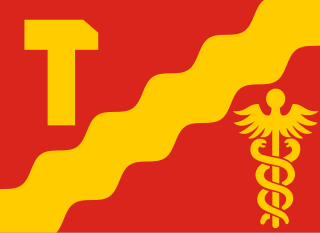
Tampere is a city in the Pirkanmaa region, located in the western part of Finland. Tampere is the most populous inland city in the Nordic countries. It has a population of 244,029; the urban area has a population of 341,696; and the metropolitan area, also known as the Tampere sub-region, has a population of 393,941 in an area of 4,970 km2 (1,920 sq mi). Tampere is the second-largest urban area and third most-populous individual municipality in Finland, after the cities of Helsinki and Espoo, and the most populous Finnish city outside the Greater Helsinki area. Today, Tampere is one of the major urban, economic, and cultural hubs in the whole inland region.

The Finnish Declaration of Independence was adopted by the Parliament of Finland on 6 December 1917. It declared Finland an independent nation, ending its autonomy within Russia as the Grand Principality of Finland, with reference to a bill simultaneously delivered to the Parliament to make Finland an independent republic instead.
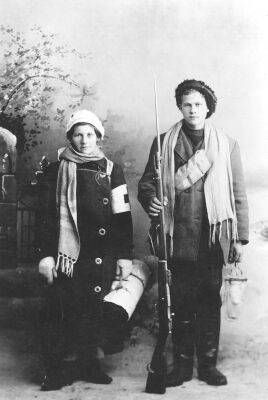
The Red Guards were the paramilitary units of the Finnish labour movement in the early 1900s. The first Red Guards were established during the 1905 general strike, but disbanded a year later. After the Russian 1917 February revolution the Red Guards were re-established and in the 1918 Finnish Civil War they formed the army of Red Finland. The combined strength of the Red Guard was about 30,000 at the beginning of the Civil War, peaking at between 90,000 and 120,000 during the course of the conflict. The number included more than 2,000 members of the Women's Guards. In May 1918, up to 80,000 Reds were captured by the victorious Whites, 12,000 to 14,000 of them died in the prison camps due to execution, disease and malnutrition. A majority of the Reds were finally pardoned in late 1918.

Finland declared its independence on 6 December 1917. The formal Declaration of Independence was only part of the long process leading to the independence of Finland.

The Finnish Socialist Workers' Republic (FSWR), more commonly referred to as Red Finland, was a self-proclaimed Finnish socialist state that ruled parts of the country during the Finnish Civil War of 1918. It was outlined on 29 January 1918 by the Finnish People's Delegation, the Reds and Red Guards of the Finnish Social Democratic Party, after the socialist revolution in Finland on 26 January 1918. Its sole prime minister was Kullervo Manner, chairman of the central committee.

Leopold Henrik Stanislaus Mechelin, known as Leo Mechelin, was a Finnish politician, professor, liberal reformer and businessman. A leading defender of the autonomy of the Grand Duchy of Finland, and of the rights of women and minorities, Mechelin's 1905–1908 government ("Mechelin's Senate") made Finland the first nation in the world with the universal right to vote and to be elected. During his period in office the freedom of expression, the press, and of assembly were introduced. Mechelin was born and died in Helsinki, Finland.

Yrjö Esalas Emanuel Mäkelin, was a Finnish Socialist, journalist, a leader of the Finnish labour movement and Member of Parliament 1908–1910, 1913–1918.

Aleksi "Ali" Aaltonen was a Finnish journalist and former lieutenant of the Russian Imperial Army, who served as the first commander-in-chief of the Finnish Red Guards from November 1917 to the end of January 1918. He was executed after the Finnish Civil War in May 1918.

The Vyborg Manifesto ; also called the Vyborg Appeal) was a proclamation signed by several Russian politicians, primarily Kadets and Trudoviks) of the dissolved First Duma on 22 July [O.S. 9 July] 1906.

The Tampere Lenin Museum is a museum devoted to Vladimir Lenin in Tampere, Finland. It was established in 1946 by the Finland–Soviet Union Society, and today it is run by The Finnish Labour Museum Werstas. It was the first museum dedicated to Lenin outside the Soviet Union, and is now the only surviving one located outside Russia.
The “Shoot on the Spot” Declaration was a statement issued by Carl Gustaf Emil Mannerheim, military leader of the Whites, on 25 February 1918, in the early stages of the Finnish Civil War. The Declaration was adopted as a rule of engagement of the White troops. Among other things, it directed the troops about the treatment of prisoners, and gave commanders of units wide powers to carry out executions at their sole discretion.

The Battle of Helsinki was a 1918 Finnish Civil War battle, fought in 12–13 April between the German troops and Finnish Whites against the Finnish Reds in Helsinki, Finland. Together with the battles of Tampere and Vyborg, it was one of the three major urban battles of the Finnish Civil War. The Germans invaded Helsinki despite the opposition of Finnish White Army leader Carl Gustaf Emil Mannerheim who wanted to attack the capital city with his own troops after Tampere had fallen on 6 April. However, the Germans had their own interest in taking Helsinki as quickly as possible and then moving further east towards the Russian border. The city had been under Red control for 11 weeks since the beginning of the war.
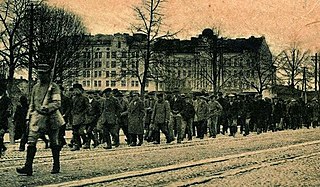
The Battle of Viipuri was a 1918 Finnish Civil War battle, fought 24–29 April between the Finnish Whites against the Finnish Reds in Viipuri. Together with the Battle of Tampere and Battle of Helsinki, it was one of the three major urban battles of the Finnish Civil War. The battle is also remembered because of its bloody aftermath, as the Whites executed up to 400 non-aligned military personnel and civilians of Russian and associated ethnicities.
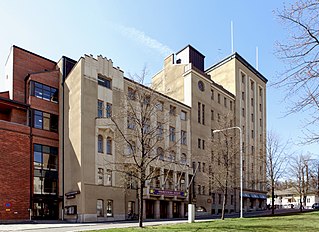
Tampere Workers' Hall is a conference and congress centre in Kaakinmaa, Tampere, Finland, located in the corner between Hämeenpuisto and Hallituskatu. It was built in 1900 by the Tampere Workers' Society as a People's House for the local working-class. The building has been expanded twice, in 1912 after the design of the architect Heikki Kaartinen and in 1930 by the architect Bertel Strömmer. Today the Workers' Hall include conference rooms, a restaurant as well as premises of the Social Democratic Party, University of Tampere and the Tampere Lenin Museum. The 1901 established Tampere Workers' Theatre was housed in the Workers' Hall until 1985 when the new theatre building was raised to the next plot.

All-female units of the paramilitary Red Guards served in the 1918 Finnish Civil War. The first Women's Guards units formed in early February in the main Finnish cities. More than 15 female Guards units were established by the end of March 1918, with a total of about 2,000 women serving. The female Guards units consisted of young industrial workers, maids, and servants. Their average age was about 20, but some were as young as 14. The women served in auxiliary units in combat.
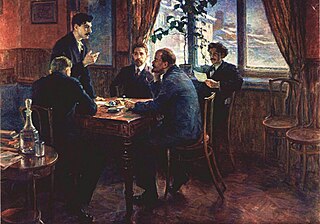
The first conference of the Russian Social Democratic Labour Party (RSDLP) took place in Tampere (Tammerfors), Grand Duchy of Finland, in December 1905. Held between the 1905 London and 1906 Stockholm party congresses at the Tampere Workers' Hall, the conference was an unofficial meeting of the Bolshevik faction of the party. It is particularly remembered for playing host to the first meeting of Vladimir Lenin and Joseph Stalin. The conference resolved to forgo participation in the new State Duma, as did most of the far left parties. They later reversed this decision in 1907.
Anarchism in Finland dates back to the early revolutionary movements of the 20th century, seeing organized activity begin in the 1960s.

Gustaf Adolf Lindström, better known under his pen name Kössi Kaatra, was a Finnish working-class poet, journalist and theatre director.

















